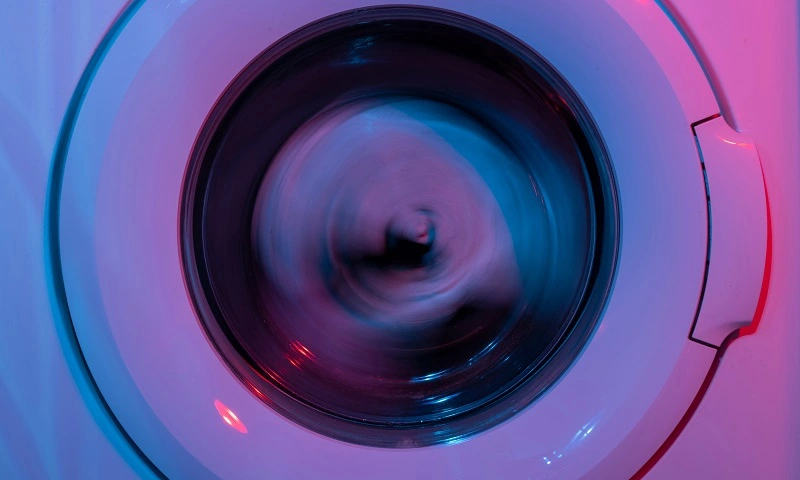Spin speed refers to the number of revolutions per minute (RPM) that the washing machine’s drum can reach during the spin cycle. This is an important factor to consider as it determines how dry your clothes will be when the cycle is finished.
A higher spin speed means that more water will be extracted from your clothes, reducing drying time and energy consumption. If you are choosing a new washing cycle, understanding spin speed can help you set the right wash settings.

What Does Spin Speed Mean On Washing Machine?
Spin speed refers to the rate at which the washing machine drum rotates during the spin cycle. The speed is measured in revolutions per minute (RPM). Higher spin speed extracts more water from the laundry, reducing the drying time and energy consumption.
It is important to consider the fabric type because each type requires a particular speed range to avoid damage and to promote effective drying. Nowadays, modern washing machines offer variable spin speeds, which allow users to customize based on their laundry needs. Choosing the proper speed ensures effective washing, better care of the fabric, and faster drying of clothes.
Generally, you can find the washers to have low, medium, and high spin speeds. Some models have a few more speed options too. Before washing the clothes, you must know the different wash programs and the spinning speeds the programs offer.
Faster the spin more water will be extracted. However, the selection of speed depends majorly on fabric type and load size.
A slower spin speed is suitable for delicate fabrics such as silk or wool to avoid damage and excessive wear and tear. A gentle spin is necessary because delicate fabric materials are more susceptible to stretching and distortion.
On the other hand, stronger fabrics like cotton or denim require a faster spin speed to extract water effectively out of them.
Similarly. selecting the right spin speed depends equally on the load size. Overloading the washing machine can result in an uneven distribution of weight, which leads to excessive vibration and potential damage to both the machine and the clothes.
Also, a smaller load may not distribute weight equally, which can affect the machine’s balance during the spin cycle.Let us now look into the different speed ranges available in the spin cycle of common washing machine types. This will help you to choose the right speed and select the right type of washer for your laundry.
Spin Speed in Different Types of Washing Machines
Variations in spin speed are found in all the different types of washing machines, such as compact, front-loading, and top-loading models. Each type has its own set of features.
| Washing Machine Type | Spin Speed Range (RPM) | Features |
|---|---|---|
| Top Loading | 500 to 1100 | Top-loading washing machines usually have a moderate spin speed range. They have a lower rpm which aids in better agitation of heavy laundry. But it may not be as effective as front-load machines which have better speed range. |
| Front Loading | 1000 to 1600 | Fast spin speed is usually found in front-loading washing machines. With faster speed, the spin cycle will remove excess water from clothes, resulting in faster drying time and energy efficiency. You can get the best spin speed setting with this type of machine according to your laundry type. |
| Portable/Compact | 800 to 1200 | Washing machines that are compact and portable are made for smaller spaces and usually have lower spin speed that ranges between front-loading and top-loading machines. They offer a balance between portability and efficiency. |
| High Efficiency | 1000 to 1600 | High-efficiency washing machines are designed to be energy-efficient, whether they are front-loading or top-loading. They usually have high RPM spin, which improves water extraction and shortens drying times. This makes them an eco-friendly option. |
Importance of Spin Cycle and its Benefits
The washing machine spin cycle plays a major role in water removal from freshly washed clothes. When a washing machine enters the spin cycle, it quickly rotates the drum and due to the centrifugal force, the excess water is removed from the cloth fibers.
This process significantly shortens the drying time and eliminates the need for an energy-consuming tumble dryer.
Also, effective water removal improves the laundry’s overall cleanliness and freshness. Because residual moisture can lead to unpleasant odors due to bacterial growth.
Therefore, the spinning phase not only helps in conserving resources but also ensures that clothes come out of the wash cycle with maximum dryness.
Here are some of the benefits of the spin cycle in washers:
Water Extraction
The primary purpose of the spin cycle is to remove the excess water from your clothes after the wash cycle.
Removing water efficiently reduces drying time, which helps in saving energy and promoting environmental sustainability.
Quicker Drying Time
Faster drying times for clothes are achieved by using higher spin speeds, such as 1200 to 1400 RPM (revolutions per minute).
This is particularly beneficial for people who prefer air-drying their laundry.
Clothes Durability
Gentle spin speeds, around 600 to 800 RPM, are suitable for delicate fabrics and garments.
To maintain the quality and durability of your clothes, avoid using high spin speeds for delicate items.
Reduced Wrinkling
There is a balance between water extraction and reduced wrinkles at medium spin speeds, which range from 800 to 1200 RPM.
This reduces the amount of ironing that is required, which is advantageous for clothes that are prone to wrinkling.
Energy Efficiency
You can minimize energy consumption by selecting the right spin speed according to the fabric type and laundry load.
This reduces energy usage and promotes eco-friendly laundry practices.
Enhanced Cleaning
By removing more dirt and detergent during the rinse cycle, higher spin speeds help in improving cleaning efficiency.
This ensures that your clothes are properly rinsed and cleaned when it comes out of the washing machine.
Potential Impact of Intense Spin on Clothes
Intense spinning during the washing process can have several potential impacts on clothes. There are risks associated with using high speeds as well as some misconceptions. Let us understand all these aspects.
Risks of High Spin Speed on Fabrics
High spin speeds in washing machines are effective for heavy-duty fabrics, but can seriously harm delicate materials. Delicate fabrics such as wool, silk, or lace, are susceptible to damage due to the powerful spinning motion.
Higher RPM can lead to excessive wear and tear on the fabric, causing it to lose its original texture and shape. This can result in the clothes becoming misshapen and stretched out, which may affect their overall appearance and fit.
Additionally, intense spinning can also lead to increased pilling on the fabric, creating a bobbly and worn-out look. The excess force and agitation from intense spinning can potentially cause the fabric to become weaker and more prone to developing holes or tears.
This can significantly reduce the lifespan of the clothing items, leading to a need for more frequent replacements.Therefore, it is important to carefully consider the intensity of the spin cycle speed when washing clothes to minimize these potential negative impacts.
To preserve the durability and quality of laundry, it is better to select an optimal spin setting and speed, ensuring gentle treatment of the laundry during washing. If you are working with a new washing machine, then understand the steps to use a washer and set the spin settings appropriately.
Influence of Spin Drying on Clothing Shrinkage
Clothes shrinkage is directly influenced by spin-drying. This mechanical process extracts excess water from fabrics and at the end of the cycle, you may find the clothes to have shrunken. This is usually caused due to poor choice of spin setting.
Spinning clothes with a high rpm spin cycle can cause the fibers to compress due to the force applied, which can result in shrinking. However, modern washing machines often feature adjustable spin speeds, allowing users to manage this influence.
A garment’s original size and fit are preserved when the appropriate speed is chosen when you’re washing. This reduces the possibility of shrinkage and maintains the integrity of clothes for a long time. Understanding and adjusting spin drying settings not only conserves clothing but also enhances the longevity of the clothes.


